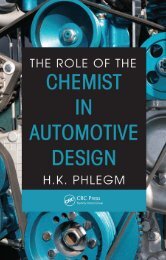Lightweight Electric/Hybrid Vehicle Design
Lightweight Electric/Hybrid Vehicle Design
Lightweight Electric/Hybrid Vehicle Design
Create successful ePaper yourself
Turn your PDF publications into a flip-book with our unique Google optimized e-Paper software.
5<br />
Battery/fuel-cell EV design packages 105<br />
Battery/fuel-cell EV design packages<br />
5.1 Introduction<br />
The rapidly developing technology of EV design precludes the description of a definitive universal<br />
package because the substantial forces which shape the EV market tend to cause quite sudden<br />
major changes in direction by the key players, and there are a number of different EV categories<br />
with different packages. For passenger cars, it seems that the converted standard IC-engine driven<br />
car may be giving way to a more specifically designed package either for fuel-cell electric or<br />
hybrid drive. While the volume builders may lean towards the retention of standard platform and<br />
body shell, it seems likely that the more specialist builder will try and fill the niches for particular<br />
market segments such as the compact city car. It is thus very important to view the EV in the wider<br />
perspective of its market and the wider transportation system of which it might become a part.<br />
Because electric drive has a long history, quite a large number of different configurations have<br />
already been tried, albeit mostly only for particular concept designs. As many established automotive<br />
engineers, brought up in the IC-engine era, now face the real possibility of fuel-cell driven<br />
production vehicles, the fundamentals of electric traction and the experience gained by past EV<br />
builders are now of real interest to those contemplating a move to that sector. A review of the<br />
current ‘state of play’ in sole electric drive and associated energy storage systems is thus provided,<br />
while hybrid drive and fuel-cell applications will be considered in the following chapter.<br />
5.2 <strong>Electric</strong> batteries<br />
According to battery maker, Exide, the state of development of different battery systems by different<br />
suppliers puts the foreseeable time availability for the principal battery contenders, relative to the<br />
company’s particular sphere of interest, lead–acid – as in Fig. 5.1a.<br />
5.2.1 ADVANCED LEAD–ACID<br />
The lead–acid battery is attractive for its comparatively low cost and an existing infrastructure for<br />
charging, servicing and recyclable disposal. A number of special high energy versions have been<br />
devised such as that shown at (b), due to researchers at the University of Idaho. This battery<br />
module has three cells, each having a stack of double-lugged plates separated by microporous<br />
glass mats. High specific power is obtained by using narrow plates with dual current collecting<br />
lugs and a 1:4 height to width aspect ratio. Grid resistance is thus reduced by shortening conductor<br />
lengths and specific energy is improved by plates that are thinner than conventional ones. They<br />
have higher active mass utilization at discharge rates appropriate to EV use. At an operating







